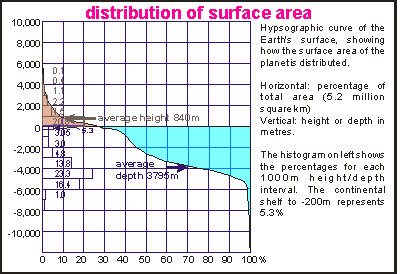 |
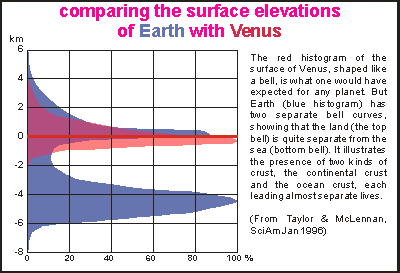 |
|
〔Seafriends Marine Conservation and Education Centreによるseafriendsの『oceanography』の中の『Oceanography: Oceans』から〕 地球の地殻表面の高度分布は2つのピークを示し、これらは大陸地殻と海洋地殻に相当する。一方、金星の表面高度分布は1つのピークしかない。 |
|
戻る<1|2|3|4|5|6|7|8|9|10|11|12|13|14|15<
|
|
| 配付プリント等 |
| 補足説明 |
|
|
 |
 |
|
〔Seafriends Marine Conservation and Education Centreによるseafriendsの『oceanography』の中の『Oceanography: Oceans』から〕 地球の地殻表面の高度分布は2つのピークを示し、これらは大陸地殻と海洋地殻に相当する。一方、金星の表面高度分布は1つのピークしかない。 |
|
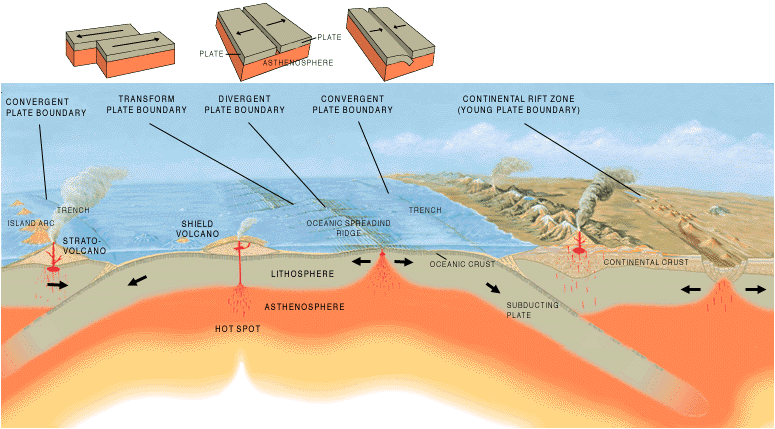 A cross section illustrating the main types of plate boundaries.(3種のプレート境界) Illustration by Jose F. Vigil from This Dynamic Planet -- a wall map produced jointly by the U.S. Geological Survey, the Smithsonian Institution, and the U.S. Naval Research Laboratory. 〔USGSのIndex of pubs.usgs.gov/gip/の『Earthquakes』の『Where Earthquakes Occur』から〕 3種のプレート境界:①発散(divergent)、②収束(convergent)、③トランスフォーム〔断層〕。 |
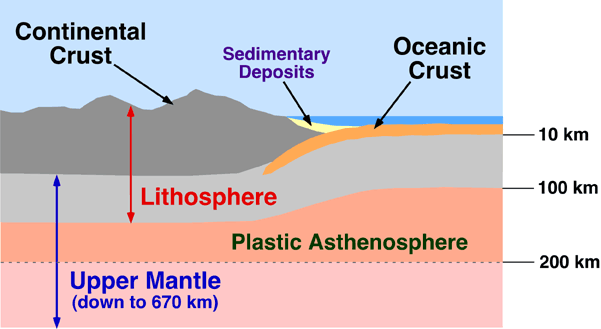 Figure 10h-2: Structure of the Earth's crust and top most layer of the upper mantle.(地殻およびマントルの最上部) The lithosphere consists of the oceanic crust, continental crust, and uppermost mantle. Beneath the lithosphere is the asthenosphere. This layer, which is also part of the upper mantle, extends to a depth of about 200 kilometers. Sedimentary deposits are commonly found at the boundaries between the continental and oceanic crust. 〔Michael Pidwirny氏によるPhysicalGeography.netの『FUNDAMENTALS OF PHYSICAL GEOGRAPHY』の『CHAPTER 10: Introduction to the Lithosphere』の中の『(h). Structure of the Earth』から〕 硬いプレート(地殻+最上部マントル)〔=リソスフェア〕は軟らかいマントル〔=アセノスフェア〕上を水平方向に移動する。 |
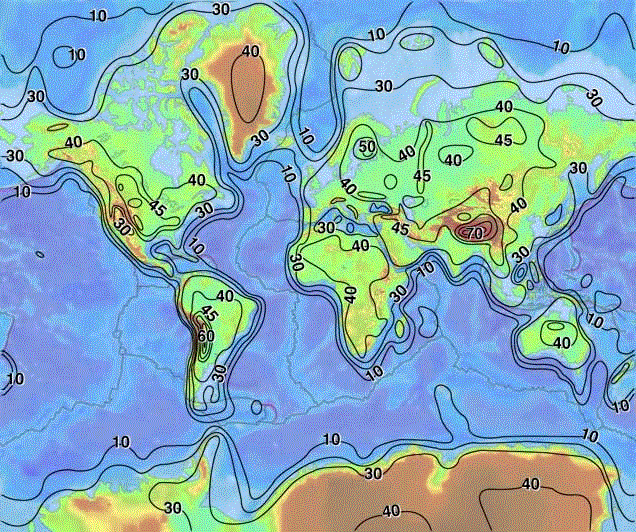 How Thick Is the Earth's Crust?(地殻の厚さ) This contour map of the thickness of the Earth's crust was developed from the CRUST 5.1 model. The contour interval is 10 km; we also include the 45 km contour for greater detail on the continents. 〔USGSによるEarthquake Hazardsの中の『The Earth's Crust』から〕 |
 〔地質調査総合センターの太田充恒氏による『希土類元素って?』の『希土類元素の地球科学』の『第1回 Oddo-Harkins (オド-ハーキンス)の法則』から〕 太陽系の元素組成は太陽光のスペクトル分析(太陽大気の化学組成)と隕石組成(とくに炭素質コンドライトの化学組成)とから求められている。これらの結果は、基本的によく一致する。 |
| 参考 |
|
|
|||||
|
|
|
||||
| 数 | % | 数 | % | ||
| 石質隕石 | 892 | 93.7 | 1048 | 58.3 | |
|
コンドライト |
822 |
86.3 |
1023 |
56.9 |
|
|
エコンドライト |
70 |
7.4 |
25 |
1.4 |
|
| 隕鉄 | 49 | 5.1 | 689 | 38.3 | |
| 石鉄隕石 | 11 | 1.2 | 61 | 3.4 | |
|
|
952 | 100.0 | 1798 | 100.0 | |
|
1992年1月1日現在の集計を示す。なおこの表には、南極大陸で大量に発見された隕石(南極隕石)は含まれていない。(F.Heide & F.Wlotzka 『Meteorites』 Springer-Verlag, 1994, p.67 の資料をもとに作成) 小森(1995)による〔『太陽系と惑星』(48pから)〕【見る→】 フォールは落下が目撃されたもので、ファインドは発見されたもの。隕鉄は地球の岩石と異なるため(風化しにくいためもある)ファインドの割合が多くなっている。また、石質隕石ではコンドルールを含むコンドライト(chondrite)が多く、それを含まないエコンドライト(achondraite)は少ない。 |
|||||
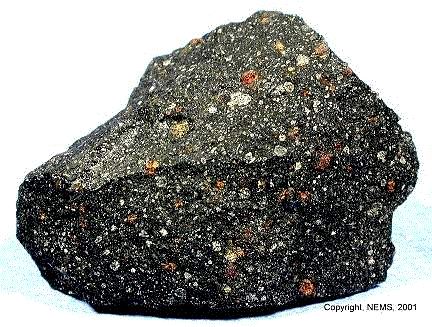 Murchison carbonaceous chondrites (23 gram fragment)(マーチソン炭素質コンドライト) 〔New England Meteoritical ServicesによるMeteorlab.comの『Current Lab Photo』の『Allende and Murchison』から〕 炭素質コンドライト(マーチソン隕石)。直径~数mmのコンドルールが見える。 |
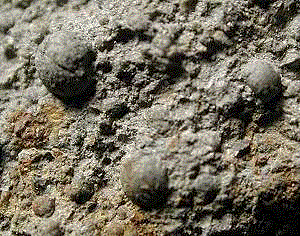 Chondrules(コンドルール、コンドリュール) 〔New England Meteoritical ServicesによるMeteorlab.comの『Meteoritics』から〕 |
/Image454.gif) <図2>隕石のできた年齢。 コンドライトとその他の隕石とに分けてあります。『新版地学教育講座 第12巻 太陽系と惑星』(東海大学出版会、1995年)から引用し、加筆、再描画。 内田洋行教育総合研究所の学びの場.com(HP/2011/5)による『科学エッセイ:隕石の分類と太陽系のなりたち』から |